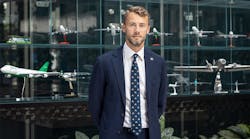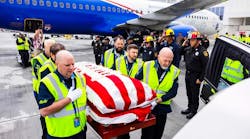Aug. 14--Oscar-winning sound designer and editor Ben Burtt has been obsessed with aviation movies since he was a little boy in New York. He was especially fond of high-flying war films.
"I remember seeing 'The Dawn Patrol' on television," said Burtt ("Star Wars," "Raiders of the Lost Ark"). "I also have to say I love the sound of airplanes. There was something that always interested me when planes would fly overhead."
On the other side of the country, Oscar-winning visual-effects artist Craig Barron grew up in San Francisco hearing colorful stories from an older cousin, who was not only a stunt pilot but also worked staging complex aerial dogfights on Howard Hughes' 1930 World War I epic "Hell's Angels."
Barron took that love for airplanes to the next level, becoming a pilot who has done acrobatic flying himself.
The two aviation buffs are exploring the history of flying and the cinema with the four-day celebration "Hollywood Takes to the Air" on Thursday through Sunday at the Academy of Motion Picture Arts and Sciences' Linwood Dunn Theater in Hollywood. Airplane miniatures and other production materials from classic aviation films will be on display throughout the weekend.
Burtt and Barron have hosted other academy screenings offering behind-the-scenes examinations of the visual effects and sound design of such films as 1938's "The Adventures of Robin Hood" and 1956's "Forbidden Planet." But "Hollywood Takes to the Air" is the first time they have explored such an expansive subject.
"We have been working on this since 2011," said Burtt. "It has taken us across the country to vaults and archives. We have enjoyed that because it's like being a history detective."
The programming begins Thursday with "Illusions of Flight," an overview of the history of aviation and cinema. Burtt and Barron will unveil a footage reel compiled by stunt flier Dick Grace that they found in the Academy Film Archive. The reel features recently discovered rare stunt and crash footage from the 1920s and '30s, when stunt pilots, not computer-generated imaging, created those death-defying flight sequences.
"Dick was what they called a 'crack-up artist,' " Barron said. "It was his job to crash a plane right in front of the cameras on cue for the director. He was a fantastic pilot and trained himself on how to survive crashing planes. He had certain tricks, like reinforcing the cockpit so it would be safer for him."
The duo pointed out that there has always been a strong association between cinema and aviation. In fact, they took flight practically at the same time.
Orville Wright made the first recorded powered flight in 1903, the same year that Edwin S. Porter's technically groundbreaking 1903 western, "The Great Train Robbery," opened.
"Aviation has always offered three words: speed, daring and romance," said Burtt. "Those are three items that cinema loves to feast upon. The public was being acquainted with aviation in the early part of the 20th century, and they would see [the plane] in the movies before they would see it for real. There was a fascination and a natural subject for motion pictures."
Aviation pictures were so popular that 1927's World War I epic "Wings," which features jaw-dropping aerial dogfights, won the first best picture Oscar.
The duo will also be screening vintage aviation films that illustrate the advances in visual effects and sound.
Friday's offering is the rarely seen 1928 World War I film "Lilac Time," with Colleen Moore and a young Gary Cooper, which features Grace's stunt work. Burtt and Barron chose this film over the better known "Wings" and "Hell's Angels" because it is rarely shown, let alone in 35 millimeter.
"Lilac Time" also was the first major aviation film released with a synchronized Vitaphone track. Though the track has long been considered lost, Burtt discovered eight minutes of the Vitaphone track and has synced it up to the film. Jon Mirsalis will provide live musical accompaniment for the other scenes.
On Saturday evening, the duo will present 1949's World War II film "Twelve O'Clock High," which features a complicated crash by noted stunt pilot Paul Mantz and actual combat footage filmed in Europe by U.S. Air Force and German Luftwaffe photographers.
One of the last pre-CGI aviation films, Phil Kaufman's 1983 "The Right Stuff," screens Sunday.
"We touch on the evolution of the technology. The way special effects were created in that era was through motion control, the techniques that were developed for 'Star Wars,'" said Burtt.
"The problem with applying that to aviation was that sometimes the shots looked too smooth because they were programmed with the computer. So Kaufman preferred to revisit some of the techniques that had been done in the '40s, '50s and '60s.
" 'The Right Stuff' takes us from the Jet Age to the age of space," Burtt said. "It is an appropriate end point of an era not only historically for aviation but technically. After that film, you don't see much revisiting physical techniques for aviation films."
------
'Hollywood Takes to the Air'
Where: Linwood Dunn Theater, 1313 Vine St., Hollywood
When: 7 p.m. Thursday through Sunday
Admission: $3 and $5
Information: http://www.oscars.org
Copyright 2014 - Los Angeles Times


